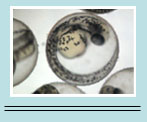

Home
Common Techniques
Classroom Experiments
Virtual Experiments
Tutorials
Games
Glossary
Links
Publishing
Opportunities
About This Site
Contact Us
ZFIN
Cite Us
Lithium Treatment to Disrupt Wnt Signaling
Courtesy of Yevgenya Grinblat, Ph.D., University of Wisconsin, Madison
The goal of this laboratory is to use Lithium Chloride to disrupt the Wnt signaling pathway, which affects body patterning, during early development of zebrafish. You will form your own hypothesis and then view embryos under the microscope to determine if and how Lithium Chloride affected pattern formation.
1. Tools
You will use several tools for the experiment today:Dissecting stereomicroscope. You will view your embryos under the microscope to determine their stage as well as to view the effects of Lithium Chloride.
Small Petri plates and Embryo Baskets. Your embryos will be contained inside the embryo basket inside a Petri dish. You will view you embryos under the microscope while they are contained in the Netwell baskets inside a Petri dish.
E3 Medium. This solution contains 5mM NaCl, 0.17 mM KCl, 0.33 mM CaCl2, 0.33 mM MgSO4, and 0.1% Methylene Blue. This medium serves as a control medium and will not have any affect on patterning.
0.3 M LiCl. Lithium Chloride, which will affect Wnt signaling pathways, will be added to the E3 Medium to the experimental embryos.
A pair of fine forceps. You can use these to dechorionate (take the shell off) the embryos and to push them around if you are careful.
Embryo loops. These are for orienting and pushing the embryos around. These are made with fishing line, capillary tubes, and super glue. You should make several of these for yourself.
Slides. Live embryos must be mounted on slides in methylcellulose before you can view them on the compound microscope.
2. Hypothesis. Before beginning this experiment, based on your knowledge of zebrafish development and the Wnt signaling pathway, devise your own hypothesis involving the effects of Lithium Chloride on development. Record your hypothesis in your notebook.
3. Staging zebrafish embryos
You will receive living embryos in a Petri dish filled with E3 at one of two stages, depending on availability: mid-blastula stages (about 2-3 hours after fertilization) or late blastula/gastrula stages (about 4-6 hours after fertilization). First, you must determine the exact stage of the embryos that you will be using for treatment using the stereo dissecting microscope (you may use the staging pdf to help). Make sure to record the treatment stage in your laboratory notebook. Then, pipette several of these embryos into a Netwell basket in a new Petri dish containing E3. Label this Dish as “Treatment Embryos”. NOTE: Besides the suggested label, ALWAYS put your name and date on each Petri dish. Then, in a new Petri plate with Netwell basket, from your ORIGINAL Petri dish, pipette several embryos of the same stage (as your treatment embryos) and label this dish, “Control Embryos”. The control plate will not receive any treatment. These embryos must be in the same developmental stage as your treatment embryos. You will use them later to compare their pattern formation with the LiCl treated embryos.Why is it important to use control embryos?
4. LiCl Treatment
Now, fill a new Petri dish with 0.3 M LiCl in E3. Label this dish as “LiCl Treatment”. Then, transfer your Netwell basket, containing the embryos from the “Treatment Embryos” Petri dish, into the new “LiCl Treatment” dish. After 20 minutes, transfer the Netwell basket back into the “Treatment Embryos” labeled dish, which contains only the E3 solution, to rinse.5. Post-treatment
Next, move these embryos into a new dish filled with fresh E3 to wash out the remaining LiCl trapped in the chorion. Now, for the final time, label a new Petri dish “Final LiCl Treated Embryos” and fill with fresh E3. Transfer your Netwell basket containing the washed, treated embryos into this new plate and put aside. Finally, transfer your control embryos from the “Control Embryos” basket into a new Petri Dish containing fresh E3, label it “Final Control Embryos”, and put aside. Now, under the dissecting microscope, view both your treated and control embryos and write down what you observe. Put both Petri dishes on the cart in the front of the room. In our next lab, we will observe these embryos after they have progressed further.Did you support your hypothesis or is it to early to tell?
Are there any observable differences between the control vs. treated embryos?
6. Other Treated Embryos
You will now be given embryos that have already been treated with LiCl at the shield stage and are at approximately 25 hours post-fertilization. Dechorionate these embryos with your fine forceps and view them under the dissecting microscope. Record in your notebook which stage each embryo is in and what type of defects you observe (e.g. eyes missing). Finally, mount these treated embryos on a glass depression slide with methylcellulose and observe their phenotype in detail under a compound microscope.7. Next Day
Dechorionate the embryos you treated, and quickly record any defects that you observe (be as specific as possible) and mount with methylcellulose on a glass slide. Take a picture of the treated embryos and control embryos.Discussion Questions:
What stages are each of these embryos in (record data for both control and treated embryos)?
Did you support your hypothesis?
Based on your observations, what type of formation does Wnt seem to be affecting (e.g. anterior-posterior axes, notochord formation etc.)?
Compare and contrast your photos of the control and treated embryos. What are the major differences?
Make sure to write down any important other important conclusions that you may find.